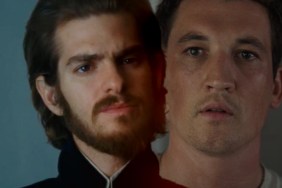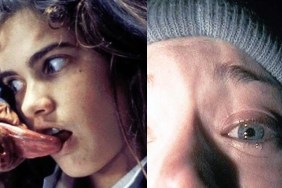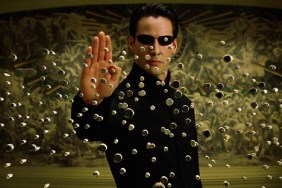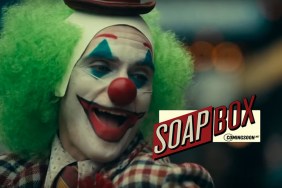
Lee Gambins Secretly Scary column continues to look at non-horror films that are secretly horror films!
In GODSPELL, New York City has never looked so picturesque. There is something irresistibly romantic and seductive in the way the color, light and spectacle of the Big Apple appears in David Greenes film adaptation of the popular ten-hander musical that opened three years before making the cinematic leap. The vivid and lyrical cinematography is one of the movies most magical features, and there are moments where the camera lifts you both physically and emotionally then brings you back to intimate close-ups of the ragamuffin clowns that occupy the emptied streets kissed by the crisp elegance and eerie airiness of what is a quintessential seventies experience. Not only does the film provide a landscape that ultimately becomes a playground for the Christ-Clown and his disciples, but it manages to bring the broad vaudevillian stylings home to showcase the casts emotive and nuanced brilliance something that the stage was unable to control and deliver. Fundamentally, David Greenes film simultaneously distances the audience from the spindly minstrel clowns so they become tiny ragdolls skipping through the emptied streets (dwarfed by their newfound Jerusalem) while completely owning the frame and presenting an almost unnerving creepiness founded in the primal unease of mugging harlequins relentlessly persistent for a captive audience. There is a sense of disturbance in GODSPELL, a strange kind of feeling aroused in both the senses and in the sensibilities of its audience. GODSPELL is not scared of taking risks, and it does it flawlessly. But there is something incredibly creepy about the film, that it simply has to be considered one of the most subversive horror films from the seventies. It has a relentless haunting quality to it that is both hypnotic and disturbing. The images that creep onto screen are designed to highlight the episodic parables played out by the minstrel clowns, however they do something more they evoke an unsettling pin-prick, a jarring combination of garish aesthete and nightmarish ghostliness.
The film opens on a piece of graffiti with a strange sound effect accompanying this urban display of youth expression. Soon the voice of the Christ-Clown (played by the wiry Victor Garber, who we shall soon meet) recites a small selection from a passage originally used in what was The Tower of Babble sequence in the original stage musical. The camera quietly glides across to our new Jerusalem: New York City in the early 1970s. The title card travels towards us over the youthful and handsome David Haskell, who comes at us ready to deliver the word of the messiah and to introduce us to the world of GODSPELL. We then cut to the hustle and bustle of modern day New York, tossed into the heart of the rat race. People are angry, dissatisfied, impatient and ruthless, and we feel no need to understand them or care about them. But it is here we meet our cast of clowns-to-be, and they are enigmatic and interesting. One is a ballerina rehearsing, one a waitress trying to take in James Joyces Ulysses, another a taxi driver stuck in traffic, and so forth. All of them are magically greeted by David Haskell, a John the Baptist figure who leads them to Central Park to the iconic Bethesda Fountain and baptises them as they sing the popular song Prepare Ye The Way of the Lord (a contagious melody with the main title as the core of the songs lyric). These New Yorkers are christened and reborn as care-free loveable clowns, and they all soon meet their leader. He comes in the form of Victor Garber, with wildly huge afro hair, a Superman t-shirt and clown face, complete with a love heart painted on his forehead.

GODSPELL is a high concept film. The idea of adapting a musical about a group of clowns in a junkyard closed off from the world by a cyclone fence who re-enact the parables of the gospel according to St. Matthew was something that perplexed film executives and directors alike.
One of the most moving moments in the film is also the most dramatically grim and theatrical. It appears late in the piece, where the Christ-Clown instructs his disciples to remove their make-up. Firstly the John the Baptist/Judas Iscariot composite removes his blood red lightning bolt and then hands out rags and make-up remover to the other clowns as Jesus insists they take off their clown-faces. Gilmer begins the procession, and soon enough the rest follow through. After this sequence, the inevitable Last Supper occurs, and then to the sombre music of On The Willows (a number originally performed by the offstage band in the stage show and here sung by unseen harmonious voices) Christ embraces each disciple. The scene is extraordinarily depressing: it is a case of the clowns having to remove their pretty face paint in order to be re-introduced into the real world, the world of banality and repression that they escaped for a moment. When one of the clowns tries to take off Jesuss make-up he is quickly stopped. The film insists that Jesus will remain a clown until his impending death. After all, in a story like GODSPELL, there is no room for this charismatic minstrel messiah to live and function in the real world. The rats of the rat race would eat him up, ignore his teachings or ridicule him. Some interesting acting choices unfold during this moment, and one of the strongest is where young Merrell Jackson looks up at Jesus with a wide vaudevillian grin and then suddenly changes his expression to one of terror. He then clings onto Jesuss legs in desperation. Another image shows Robin Lamont in a full close-up: having already said her own distinct goodbye to Christ, with the camera lingering on her while Jesus bids adieu to Katie Hanley in the distance. Robin looks into the nights eye with serenity and sense of bewilderment. The clown that sung about following Christ Day By Day has been enlightened, but she seems conflicted by the enlightenment. All this is represented in Robins incredible expression.

A number that comes late in the second half of the film that lets the audience relax again into bouncy joy is a song written specifically for the movie, Beautiful City. The song is joyous and loaded with lovely harmonies that lift the spirit and truly capture the solidarity and camaraderie of these young people, the last of the flower children. It is shot with a lens that captures the setting sun as we follow the loveable clowns from the streets of Manhattan back to Bethesda Fountain: they have come back to where they began. It is this bittersweet moment with inspired lyrics such as We see nations rise in each others eyes that gives GODSPELL a sense of community. This is a film about family, unity and friendship. The religious aspects of the film are ultimately just a structural background for what truly is a film about the celebration of community and the coming together outside of the mainstream.
But with all this joy and frivolity comes a price and GODSPELL – much like its relative JESUS CHRIST SUPERSTAR (also from 1973) – comes across like an elaborate suicide. The messiahs in these films die without any resurrection, and the bleak ending of GODSPELL is not only surprising, but also unnerving and depressing. After all the joy and sentimental acknowledgment of togetherness and compassionate companionship, there is nothing left to go back to but the cold mess of normalcy and conformity. It is as if Christs message – when told through this vaudevillian shtick – is rendered meaningless and unnecessary. As his disciples who carry his limp dead body off camera and disappear into the city, they too are rendered as unimportant and as invisible as Christs message. Another interesting fact to note is that GODSPELL opened the same year as the smash hit THE EXORCIST did another film about Christ and the purpose of faith. The Exorcist, however, remains the conservative film of the two in that Christ is presented as a savior, used to free young Regan MacNeil (Linda Blair) from demonic possession whereas in GODSPELL, Christ is a buffoon: complicated and bizarre and also left invisible and insignificant amidst the rats nest. THE EXORCIST is a fire and brimstone horror picture, complete with visceral monstrosities and a powerful intensity that jolts the nerves and gets under the skin, however its message is loud and clear the protagonist, Chris MacNeil (Ellen Burstyn) is a libertine actress with no religious convictions but she is forced to seek the help of Jesuit priests to help save her daughter from the grips of Satanic forces. However, in GODSPELL, the disciples re-enter the world of the non-believers and disappear, carrying their dead messiah out with them. Both The Exorcist and GODSPELL are incredibly important films about the mystery of faith and speak volumes about the message of the messianic, both films come from surprisingly different attitudes however: the horror film tells us that there is good in the world and that this goodness can triumph over evil (albeit sacrifices must be made) and the musical tells us that the message of Christ can be completely insignificant, alien and turned invisible. These are two films that sit at the same moral compass of cinematic experience, co-existing within theme and context but at polar ends of the structure of climactic outcome: GODSPELL ends on a downer, The Exorcist however leaves it ambiguous, but all in all with a secured notion that God is in his heaven, and a little girl is free from malevolence. But little Regan MacNeils older counterparts (dressed in their clown garb parading around an emptied New York City) return to the facelessness of the real world and quietly fade into faithless normalcy.









